Supply Chain Management Analysis for Sainsbury's: MGT 6801 Report
VerifiedAdded on 2022/12/26
|11
|2944
|68
Report
AI Summary
This report provides a comprehensive analysis of Sainsbury's supply chain management, focusing on key areas such as customer service and inventory management, transportation and logistics, warehousing and capacity, and the company's competitive advantages. The report examines how Sainsbury's manages its inventory using safety stock and its relationship with IBM. It explores the modes of transportation used, including the company's use of IT and logistics service providers (LSPs). The report differentiates between supply and demand-side transportation and assesses the efficiency of Sainsbury's supply chain. Furthermore, the report details Sainsbury's warehousing and capacity management strategies, including the five-step inventory management model. The analysis highlights the company's competitive advantages, emphasizing its focus on customer satisfaction, effective logistics, and the use of technology like Blue Yonder. The report concludes with an assessment of Sainsbury's supply chain, suggesting potential areas for improvement.
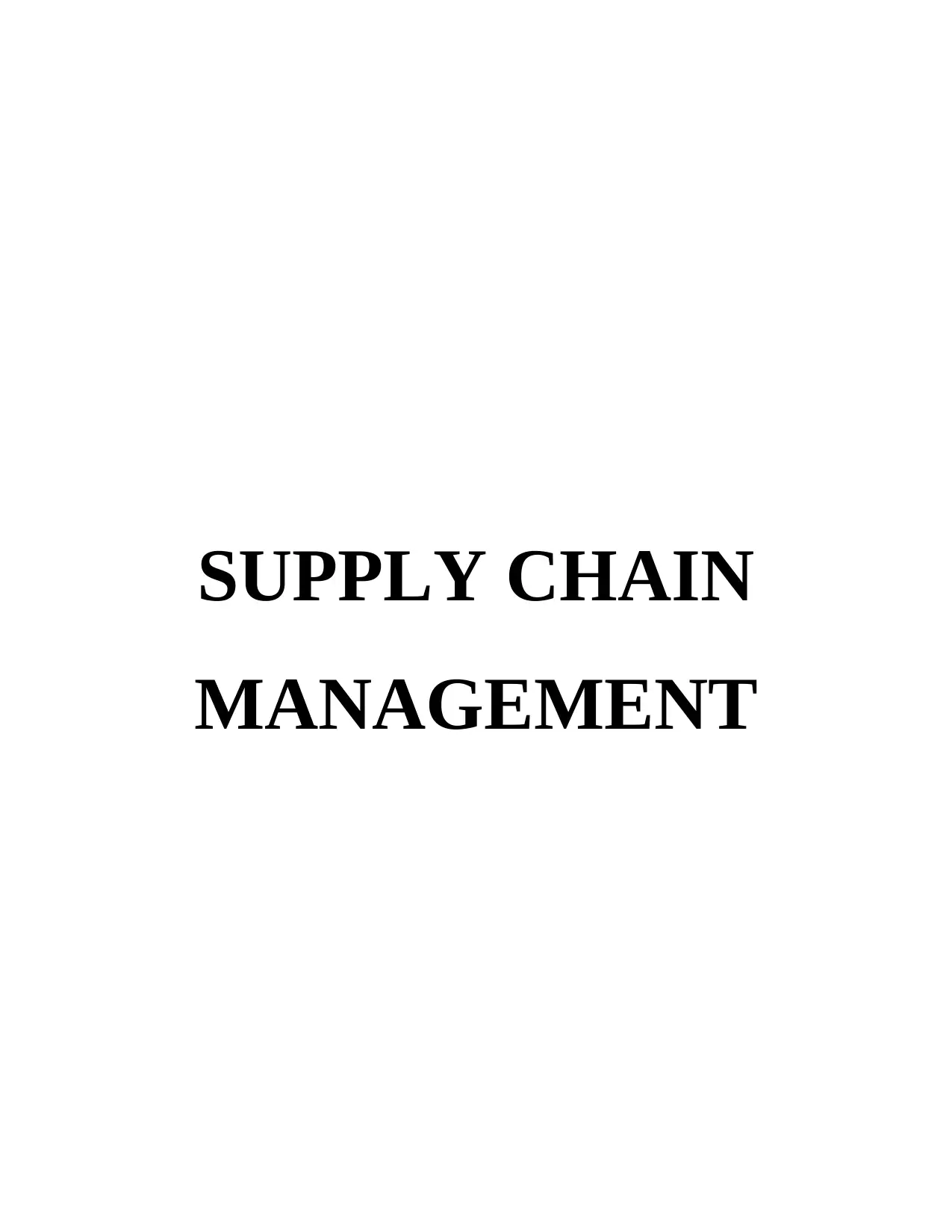
SUPPLY CHAIN
MANAGEMENT
MANAGEMENT
Paraphrase This Document
Need a fresh take? Get an instant paraphrase of this document with our AI Paraphraser
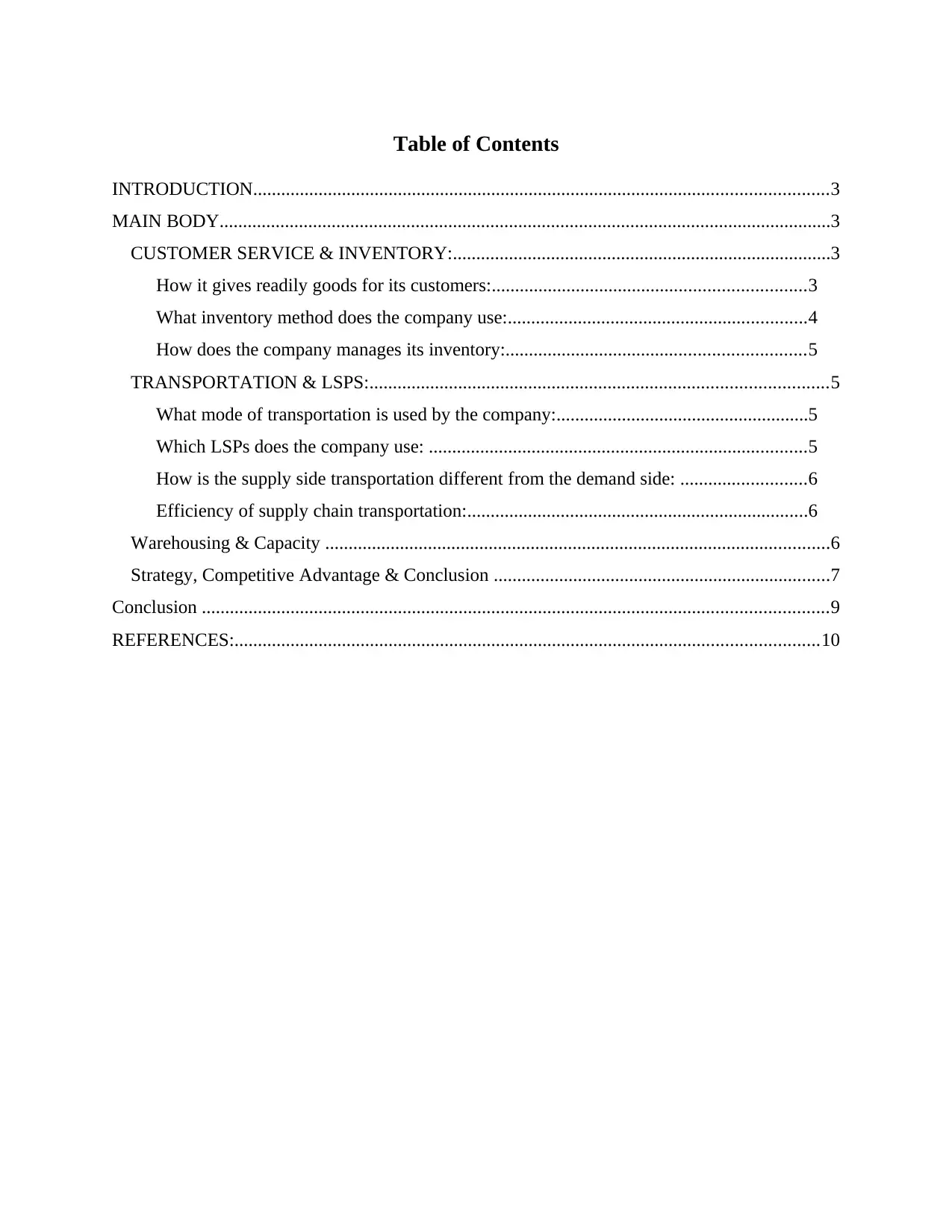
Table of Contents
INTRODUCTION...........................................................................................................................3
MAIN BODY...................................................................................................................................3
CUSTOMER SERVICE & INVENTORY:.................................................................................3
How it gives readily goods for its customers:...................................................................3
What inventory method does the company use:................................................................4
How does the company manages its inventory:................................................................5
TRANSPORTATION & LSPS:..................................................................................................5
What mode of transportation is used by the company:......................................................5
Which LSPs does the company use: .................................................................................5
How is the supply side transportation different from the demand side: ...........................6
Efficiency of supply chain transportation:.........................................................................6
Warehousing & Capacity ............................................................................................................6
Strategy, Competitive Advantage & Conclusion ........................................................................7
Conclusion ......................................................................................................................................9
REFERENCES:.............................................................................................................................10
INTRODUCTION...........................................................................................................................3
MAIN BODY...................................................................................................................................3
CUSTOMER SERVICE & INVENTORY:.................................................................................3
How it gives readily goods for its customers:...................................................................3
What inventory method does the company use:................................................................4
How does the company manages its inventory:................................................................5
TRANSPORTATION & LSPS:..................................................................................................5
What mode of transportation is used by the company:......................................................5
Which LSPs does the company use: .................................................................................5
How is the supply side transportation different from the demand side: ...........................6
Efficiency of supply chain transportation:.........................................................................6
Warehousing & Capacity ............................................................................................................6
Strategy, Competitive Advantage & Conclusion ........................................................................7
Conclusion ......................................................................................................................................9
REFERENCES:.............................................................................................................................10
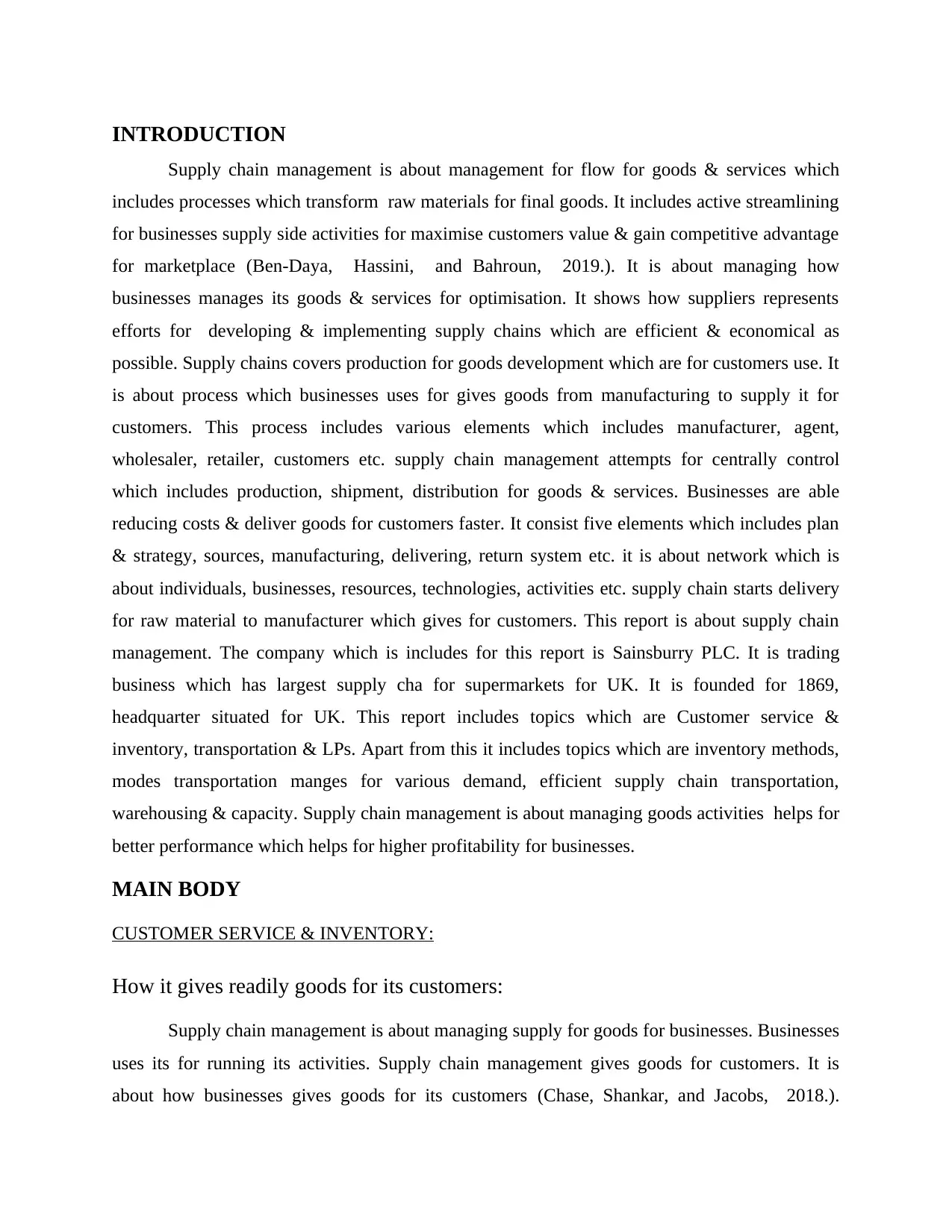
INTRODUCTION
Supply chain management is about management for flow for goods & services which
includes processes which transform raw materials for final goods. It includes active streamlining
for businesses supply side activities for maximise customers value & gain competitive advantage
for marketplace (Ben-Daya, Hassini, and Bahroun, 2019.). It is about managing how
businesses manages its goods & services for optimisation. It shows how suppliers represents
efforts for developing & implementing supply chains which are efficient & economical as
possible. Supply chains covers production for goods development which are for customers use. It
is about process which businesses uses for gives goods from manufacturing to supply it for
customers. This process includes various elements which includes manufacturer, agent,
wholesaler, retailer, customers etc. supply chain management attempts for centrally control
which includes production, shipment, distribution for goods & services. Businesses are able
reducing costs & deliver goods for customers faster. It consist five elements which includes plan
& strategy, sources, manufacturing, delivering, return system etc. it is about network which is
about individuals, businesses, resources, technologies, activities etc. supply chain starts delivery
for raw material to manufacturer which gives for customers. This report is about supply chain
management. The company which is includes for this report is Sainsburry PLC. It is trading
business which has largest supply cha for supermarkets for UK. It is founded for 1869,
headquarter situated for UK. This report includes topics which are Customer service &
inventory, transportation & LPs. Apart from this it includes topics which are inventory methods,
modes transportation manges for various demand, efficient supply chain transportation,
warehousing & capacity. Supply chain management is about managing goods activities helps for
better performance which helps for higher profitability for businesses.
MAIN BODY
CUSTOMER SERVICE & INVENTORY:
How it gives readily goods for its customers:
Supply chain management is about managing supply for goods for businesses. Businesses
uses its for running its activities. Supply chain management gives goods for customers. It is
about how businesses gives goods for its customers (Chase, Shankar, and Jacobs, 2018.).
Supply chain management is about management for flow for goods & services which
includes processes which transform raw materials for final goods. It includes active streamlining
for businesses supply side activities for maximise customers value & gain competitive advantage
for marketplace (Ben-Daya, Hassini, and Bahroun, 2019.). It is about managing how
businesses manages its goods & services for optimisation. It shows how suppliers represents
efforts for developing & implementing supply chains which are efficient & economical as
possible. Supply chains covers production for goods development which are for customers use. It
is about process which businesses uses for gives goods from manufacturing to supply it for
customers. This process includes various elements which includes manufacturer, agent,
wholesaler, retailer, customers etc. supply chain management attempts for centrally control
which includes production, shipment, distribution for goods & services. Businesses are able
reducing costs & deliver goods for customers faster. It consist five elements which includes plan
& strategy, sources, manufacturing, delivering, return system etc. it is about network which is
about individuals, businesses, resources, technologies, activities etc. supply chain starts delivery
for raw material to manufacturer which gives for customers. This report is about supply chain
management. The company which is includes for this report is Sainsburry PLC. It is trading
business which has largest supply cha for supermarkets for UK. It is founded for 1869,
headquarter situated for UK. This report includes topics which are Customer service &
inventory, transportation & LPs. Apart from this it includes topics which are inventory methods,
modes transportation manges for various demand, efficient supply chain transportation,
warehousing & capacity. Supply chain management is about managing goods activities helps for
better performance which helps for higher profitability for businesses.
MAIN BODY
CUSTOMER SERVICE & INVENTORY:
How it gives readily goods for its customers:
Supply chain management is about managing supply for goods for businesses. Businesses
uses its for running its activities. Supply chain management gives goods for customers. It is
about how businesses gives goods for its customers (Chase, Shankar, and Jacobs, 2018.).
⊘ This is a preview!⊘
Do you want full access?
Subscribe today to unlock all pages.

Trusted by 1+ million students worldwide
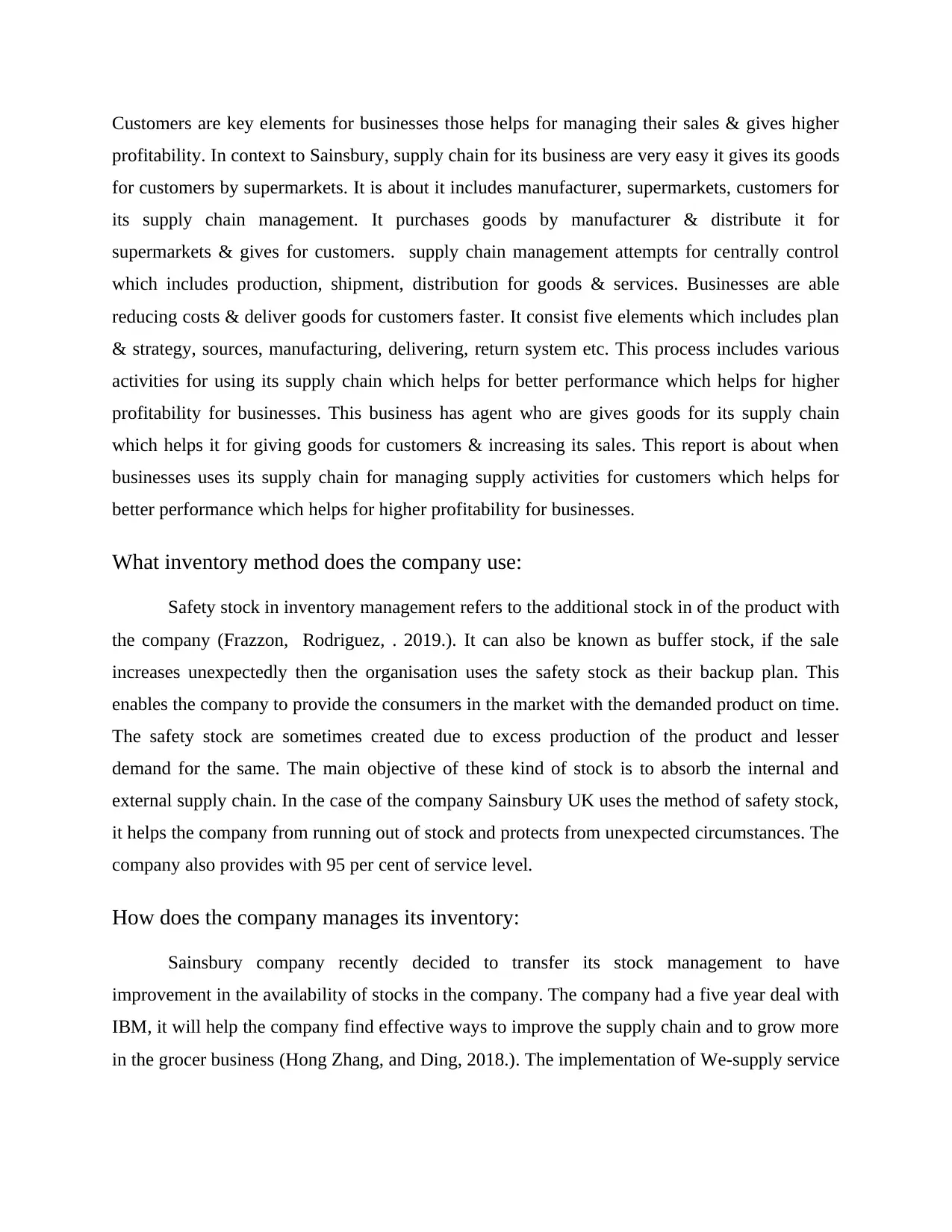
Customers are key elements for businesses those helps for managing their sales & gives higher
profitability. In context to Sainsbury, supply chain for its business are very easy it gives its goods
for customers by supermarkets. It is about it includes manufacturer, supermarkets, customers for
its supply chain management. It purchases goods by manufacturer & distribute it for
supermarkets & gives for customers. supply chain management attempts for centrally control
which includes production, shipment, distribution for goods & services. Businesses are able
reducing costs & deliver goods for customers faster. It consist five elements which includes plan
& strategy, sources, manufacturing, delivering, return system etc. This process includes various
activities for using its supply chain which helps for better performance which helps for higher
profitability for businesses. This business has agent who are gives goods for its supply chain
which helps it for giving goods for customers & increasing its sales. This report is about when
businesses uses its supply chain for managing supply activities for customers which helps for
better performance which helps for higher profitability for businesses.
What inventory method does the company use:
Safety stock in inventory management refers to the additional stock in of the product with
the company (Frazzon, Rodriguez, . 2019.). It can also be known as buffer stock, if the sale
increases unexpectedly then the organisation uses the safety stock as their backup plan. This
enables the company to provide the consumers in the market with the demanded product on time.
The safety stock are sometimes created due to excess production of the product and lesser
demand for the same. The main objective of these kind of stock is to absorb the internal and
external supply chain. In the case of the company Sainsbury UK uses the method of safety stock,
it helps the company from running out of stock and protects from unexpected circumstances. The
company also provides with 95 per cent of service level.
How does the company manages its inventory:
Sainsbury company recently decided to transfer its stock management to have
improvement in the availability of stocks in the company. The company had a five year deal with
IBM, it will help the company find effective ways to improve the supply chain and to grow more
in the grocer business (Hong Zhang, and Ding, 2018.). The implementation of We-supply service
profitability. In context to Sainsbury, supply chain for its business are very easy it gives its goods
for customers by supermarkets. It is about it includes manufacturer, supermarkets, customers for
its supply chain management. It purchases goods by manufacturer & distribute it for
supermarkets & gives for customers. supply chain management attempts for centrally control
which includes production, shipment, distribution for goods & services. Businesses are able
reducing costs & deliver goods for customers faster. It consist five elements which includes plan
& strategy, sources, manufacturing, delivering, return system etc. This process includes various
activities for using its supply chain which helps for better performance which helps for higher
profitability for businesses. This business has agent who are gives goods for its supply chain
which helps it for giving goods for customers & increasing its sales. This report is about when
businesses uses its supply chain for managing supply activities for customers which helps for
better performance which helps for higher profitability for businesses.
What inventory method does the company use:
Safety stock in inventory management refers to the additional stock in of the product with
the company (Frazzon, Rodriguez, . 2019.). It can also be known as buffer stock, if the sale
increases unexpectedly then the organisation uses the safety stock as their backup plan. This
enables the company to provide the consumers in the market with the demanded product on time.
The safety stock are sometimes created due to excess production of the product and lesser
demand for the same. The main objective of these kind of stock is to absorb the internal and
external supply chain. In the case of the company Sainsbury UK uses the method of safety stock,
it helps the company from running out of stock and protects from unexpected circumstances. The
company also provides with 95 per cent of service level.
How does the company manages its inventory:
Sainsbury company recently decided to transfer its stock management to have
improvement in the availability of stocks in the company. The company had a five year deal with
IBM, it will help the company find effective ways to improve the supply chain and to grow more
in the grocer business (Hong Zhang, and Ding, 2018.). The implementation of We-supply service
Paraphrase This Document
Need a fresh take? Get an instant paraphrase of this document with our AI Paraphraser
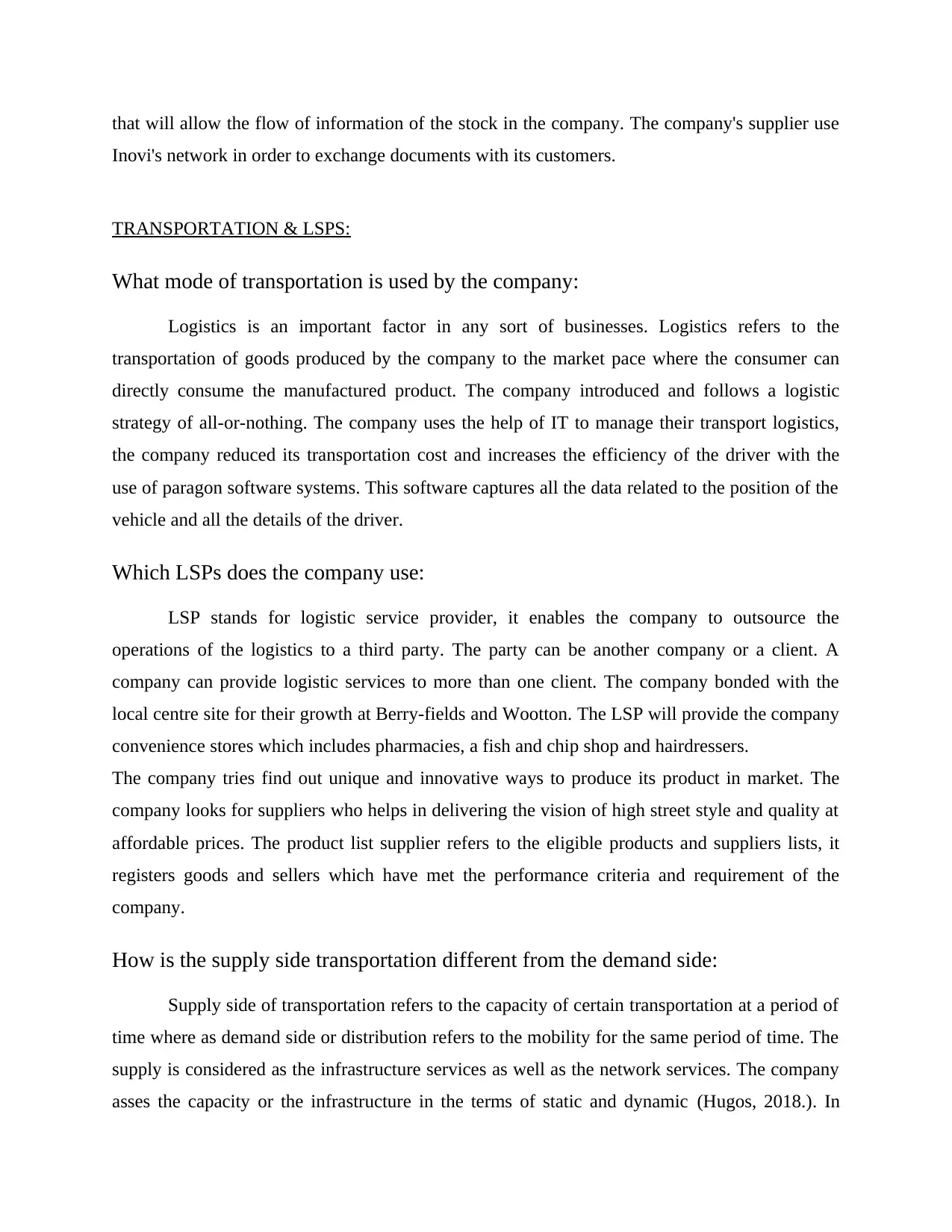
that will allow the flow of information of the stock in the company. The company's supplier use
Inovi's network in order to exchange documents with its customers.
TRANSPORTATION & LSPS:
What mode of transportation is used by the company:
Logistics is an important factor in any sort of businesses. Logistics refers to the
transportation of goods produced by the company to the market pace where the consumer can
directly consume the manufactured product. The company introduced and follows a logistic
strategy of all-or-nothing. The company uses the help of IT to manage their transport logistics,
the company reduced its transportation cost and increases the efficiency of the driver with the
use of paragon software systems. This software captures all the data related to the position of the
vehicle and all the details of the driver.
Which LSPs does the company use:
LSP stands for logistic service provider, it enables the company to outsource the
operations of the logistics to a third party. The party can be another company or a client. A
company can provide logistic services to more than one client. The company bonded with the
local centre site for their growth at Berry-fields and Wootton. The LSP will provide the company
convenience stores which includes pharmacies, a fish and chip shop and hairdressers.
The company tries find out unique and innovative ways to produce its product in market. The
company looks for suppliers who helps in delivering the vision of high street style and quality at
affordable prices. The product list supplier refers to the eligible products and suppliers lists, it
registers goods and sellers which have met the performance criteria and requirement of the
company.
How is the supply side transportation different from the demand side:
Supply side of transportation refers to the capacity of certain transportation at a period of
time where as demand side or distribution refers to the mobility for the same period of time. The
supply is considered as the infrastructure services as well as the network services. The company
asses the capacity or the infrastructure in the terms of static and dynamic (Hugos, 2018.). In
Inovi's network in order to exchange documents with its customers.
TRANSPORTATION & LSPS:
What mode of transportation is used by the company:
Logistics is an important factor in any sort of businesses. Logistics refers to the
transportation of goods produced by the company to the market pace where the consumer can
directly consume the manufactured product. The company introduced and follows a logistic
strategy of all-or-nothing. The company uses the help of IT to manage their transport logistics,
the company reduced its transportation cost and increases the efficiency of the driver with the
use of paragon software systems. This software captures all the data related to the position of the
vehicle and all the details of the driver.
Which LSPs does the company use:
LSP stands for logistic service provider, it enables the company to outsource the
operations of the logistics to a third party. The party can be another company or a client. A
company can provide logistic services to more than one client. The company bonded with the
local centre site for their growth at Berry-fields and Wootton. The LSP will provide the company
convenience stores which includes pharmacies, a fish and chip shop and hairdressers.
The company tries find out unique and innovative ways to produce its product in market. The
company looks for suppliers who helps in delivering the vision of high street style and quality at
affordable prices. The product list supplier refers to the eligible products and suppliers lists, it
registers goods and sellers which have met the performance criteria and requirement of the
company.
How is the supply side transportation different from the demand side:
Supply side of transportation refers to the capacity of certain transportation at a period of
time where as demand side or distribution refers to the mobility for the same period of time. The
supply is considered as the infrastructure services as well as the network services. The company
asses the capacity or the infrastructure in the terms of static and dynamic (Hugos, 2018.). In
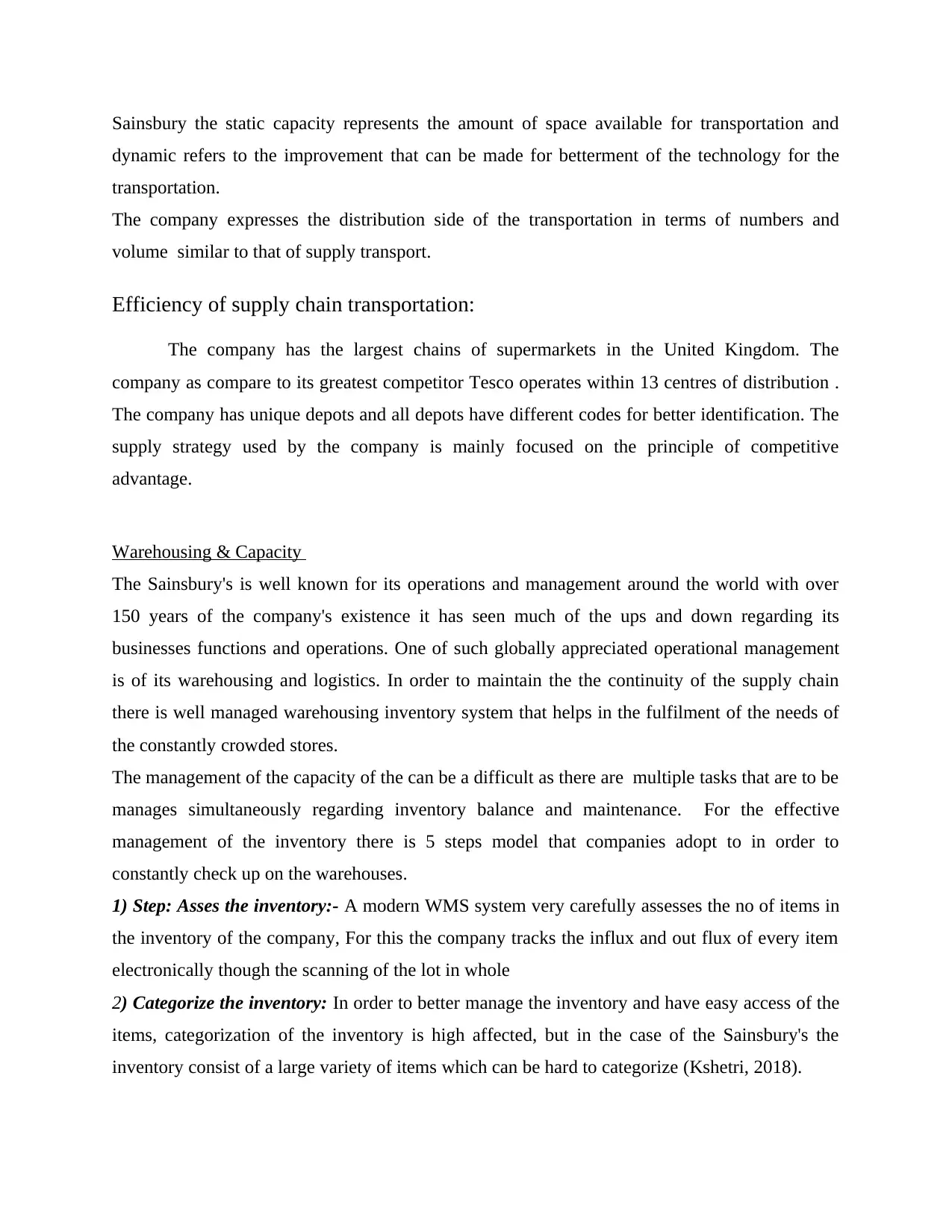
Sainsbury the static capacity represents the amount of space available for transportation and
dynamic refers to the improvement that can be made for betterment of the technology for the
transportation.
The company expresses the distribution side of the transportation in terms of numbers and
volume similar to that of supply transport.
Efficiency of supply chain transportation:
The company has the largest chains of supermarkets in the United Kingdom. The
company as compare to its greatest competitor Tesco operates within 13 centres of distribution .
The company has unique depots and all depots have different codes for better identification. The
supply strategy used by the company is mainly focused on the principle of competitive
advantage.
Warehousing & Capacity
The Sainsbury's is well known for its operations and management around the world with over
150 years of the company's existence it has seen much of the ups and down regarding its
businesses functions and operations. One of such globally appreciated operational management
is of its warehousing and logistics. In order to maintain the the continuity of the supply chain
there is well managed warehousing inventory system that helps in the fulfilment of the needs of
the constantly crowded stores.
The management of the capacity of the can be a difficult as there are multiple tasks that are to be
manages simultaneously regarding inventory balance and maintenance. For the effective
management of the inventory there is 5 steps model that companies adopt to in order to
constantly check up on the warehouses.
1) Step: Asses the inventory:- A modern WMS system very carefully assesses the no of items in
the inventory of the company, For this the company tracks the influx and out flux of every item
electronically though the scanning of the lot in whole
2) Categorize the inventory: In order to better manage the inventory and have easy access of the
items, categorization of the inventory is high affected, but in the case of the Sainsbury's the
inventory consist of a large variety of items which can be hard to categorize (Kshetri, 2018).
dynamic refers to the improvement that can be made for betterment of the technology for the
transportation.
The company expresses the distribution side of the transportation in terms of numbers and
volume similar to that of supply transport.
Efficiency of supply chain transportation:
The company has the largest chains of supermarkets in the United Kingdom. The
company as compare to its greatest competitor Tesco operates within 13 centres of distribution .
The company has unique depots and all depots have different codes for better identification. The
supply strategy used by the company is mainly focused on the principle of competitive
advantage.
Warehousing & Capacity
The Sainsbury's is well known for its operations and management around the world with over
150 years of the company's existence it has seen much of the ups and down regarding its
businesses functions and operations. One of such globally appreciated operational management
is of its warehousing and logistics. In order to maintain the the continuity of the supply chain
there is well managed warehousing inventory system that helps in the fulfilment of the needs of
the constantly crowded stores.
The management of the capacity of the can be a difficult as there are multiple tasks that are to be
manages simultaneously regarding inventory balance and maintenance. For the effective
management of the inventory there is 5 steps model that companies adopt to in order to
constantly check up on the warehouses.
1) Step: Asses the inventory:- A modern WMS system very carefully assesses the no of items in
the inventory of the company, For this the company tracks the influx and out flux of every item
electronically though the scanning of the lot in whole
2) Categorize the inventory: In order to better manage the inventory and have easy access of the
items, categorization of the inventory is high affected, but in the case of the Sainsbury's the
inventory consist of a large variety of items which can be hard to categorize (Kshetri, 2018).
⊘ This is a preview!⊘
Do you want full access?
Subscribe today to unlock all pages.

Trusted by 1+ million students worldwide
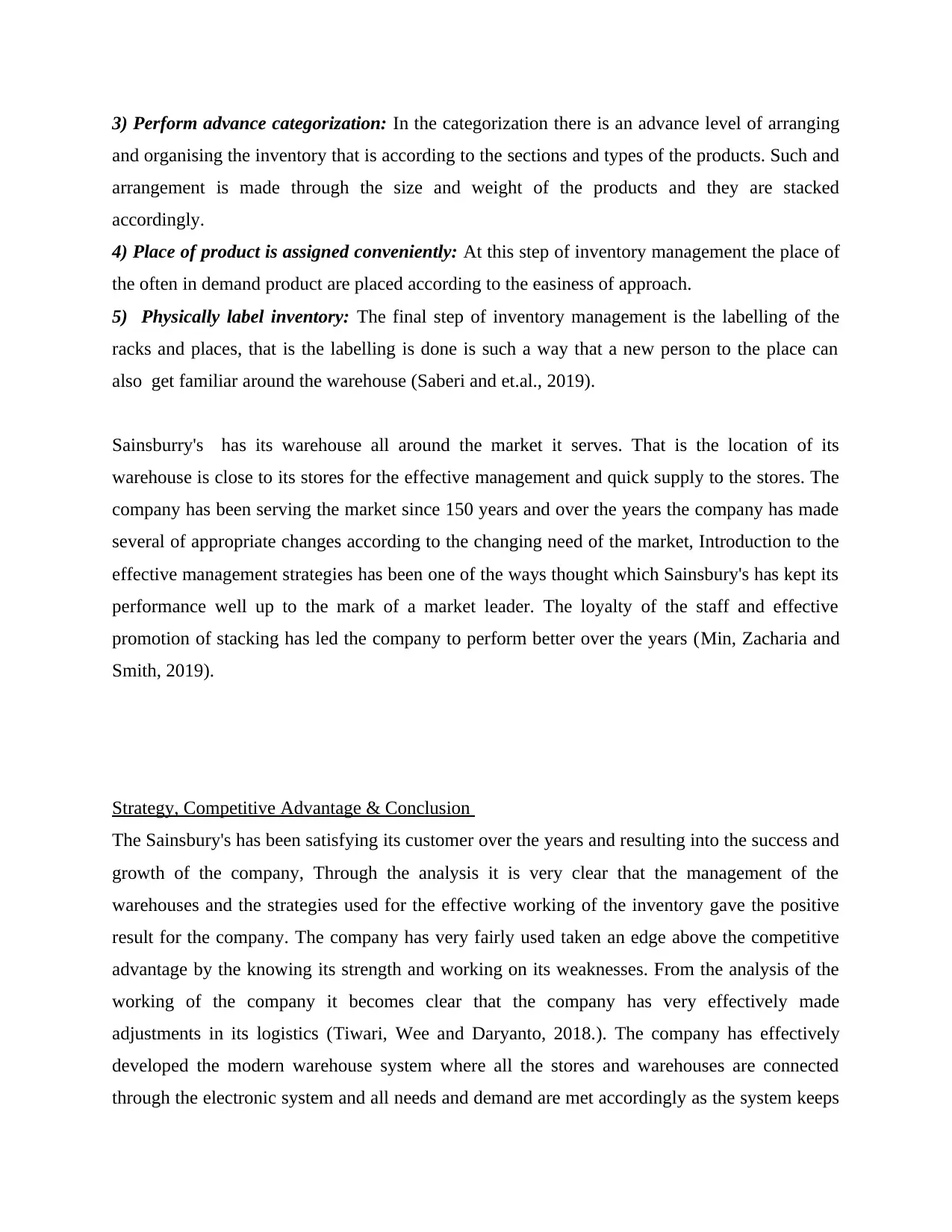
3) Perform advance categorization: In the categorization there is an advance level of arranging
and organising the inventory that is according to the sections and types of the products. Such and
arrangement is made through the size and weight of the products and they are stacked
accordingly.
4) Place of product is assigned conveniently: At this step of inventory management the place of
the often in demand product are placed according to the easiness of approach.
5) Physically label inventory: The final step of inventory management is the labelling of the
racks and places, that is the labelling is done is such a way that a new person to the place can
also get familiar around the warehouse (Saberi and et.al., 2019).
Sainsburry's has its warehouse all around the market it serves. That is the location of its
warehouse is close to its stores for the effective management and quick supply to the stores. The
company has been serving the market since 150 years and over the years the company has made
several of appropriate changes according to the changing need of the market, Introduction to the
effective management strategies has been one of the ways thought which Sainsbury's has kept its
performance well up to the mark of a market leader. The loyalty of the staff and effective
promotion of stacking has led the company to perform better over the years (Min, Zacharia and
Smith, 2019).
Strategy, Competitive Advantage & Conclusion
The Sainsbury's has been satisfying its customer over the years and resulting into the success and
growth of the company, Through the analysis it is very clear that the management of the
warehouses and the strategies used for the effective working of the inventory gave the positive
result for the company. The company has very fairly used taken an edge above the competitive
advantage by the knowing its strength and working on its weaknesses. From the analysis of the
working of the company it becomes clear that the company has very effectively made
adjustments in its logistics (Tiwari, Wee and Daryanto, 2018.). The company has effectively
developed the modern warehouse system where all the stores and warehouses are connected
through the electronic system and all needs and demand are met accordingly as the system keeps
and organising the inventory that is according to the sections and types of the products. Such and
arrangement is made through the size and weight of the products and they are stacked
accordingly.
4) Place of product is assigned conveniently: At this step of inventory management the place of
the often in demand product are placed according to the easiness of approach.
5) Physically label inventory: The final step of inventory management is the labelling of the
racks and places, that is the labelling is done is such a way that a new person to the place can
also get familiar around the warehouse (Saberi and et.al., 2019).
Sainsburry's has its warehouse all around the market it serves. That is the location of its
warehouse is close to its stores for the effective management and quick supply to the stores. The
company has been serving the market since 150 years and over the years the company has made
several of appropriate changes according to the changing need of the market, Introduction to the
effective management strategies has been one of the ways thought which Sainsbury's has kept its
performance well up to the mark of a market leader. The loyalty of the staff and effective
promotion of stacking has led the company to perform better over the years (Min, Zacharia and
Smith, 2019).
Strategy, Competitive Advantage & Conclusion
The Sainsbury's has been satisfying its customer over the years and resulting into the success and
growth of the company, Through the analysis it is very clear that the management of the
warehouses and the strategies used for the effective working of the inventory gave the positive
result for the company. The company has very fairly used taken an edge above the competitive
advantage by the knowing its strength and working on its weaknesses. From the analysis of the
working of the company it becomes clear that the company has very effectively made
adjustments in its logistics (Tiwari, Wee and Daryanto, 2018.). The company has effectively
developed the modern warehouse system where all the stores and warehouses are connected
through the electronic system and all needs and demand are met accordingly as the system keeps
Paraphrase This Document
Need a fresh take? Get an instant paraphrase of this document with our AI Paraphraser
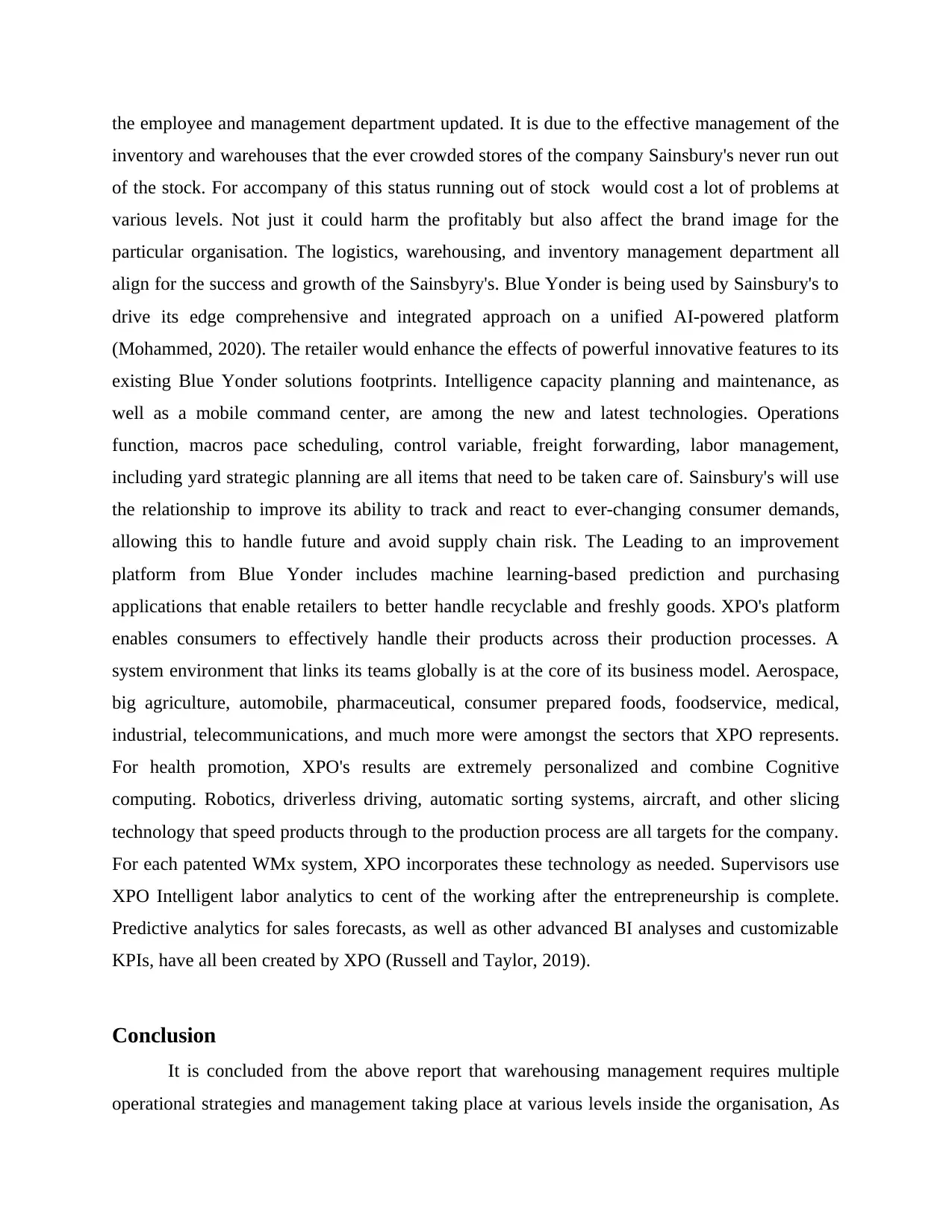
the employee and management department updated. It is due to the effective management of the
inventory and warehouses that the ever crowded stores of the company Sainsbury's never run out
of the stock. For accompany of this status running out of stock would cost a lot of problems at
various levels. Not just it could harm the profitably but also affect the brand image for the
particular organisation. The logistics, warehousing, and inventory management department all
align for the success and growth of the Sainsbyry's. Blue Yonder is being used by Sainsbury's to
drive its edge comprehensive and integrated approach on a unified AI-powered platform
(Mohammed, 2020). The retailer would enhance the effects of powerful innovative features to its
existing Blue Yonder solutions footprints. Intelligence capacity planning and maintenance, as
well as a mobile command center, are among the new and latest technologies. Operations
function, macros pace scheduling, control variable, freight forwarding, labor management,
including yard strategic planning are all items that need to be taken care of. Sainsbury's will use
the relationship to improve its ability to track and react to ever-changing consumer demands,
allowing this to handle future and avoid supply chain risk. The Leading to an improvement
platform from Blue Yonder includes machine learning-based prediction and purchasing
applications that enable retailers to better handle recyclable and freshly goods. XPO's platform
enables consumers to effectively handle their products across their production processes. A
system environment that links its teams globally is at the core of its business model. Aerospace,
big agriculture, automobile, pharmaceutical, consumer prepared foods, foodservice, medical,
industrial, telecommunications, and much more were amongst the sectors that XPO represents.
For health promotion, XPO's results are extremely personalized and combine Cognitive
computing. Robotics, driverless driving, automatic sorting systems, aircraft, and other slicing
technology that speed products through to the production process are all targets for the company.
For each patented WMx system, XPO incorporates these technology as needed. Supervisors use
XPO Intelligent labor analytics to cent of the working after the entrepreneurship is complete.
Predictive analytics for sales forecasts, as well as other advanced BI analyses and customizable
KPIs, have all been created by XPO (Russell and Taylor, 2019).
Conclusion
It is concluded from the above report that warehousing management requires multiple
operational strategies and management taking place at various levels inside the organisation, As
inventory and warehouses that the ever crowded stores of the company Sainsbury's never run out
of the stock. For accompany of this status running out of stock would cost a lot of problems at
various levels. Not just it could harm the profitably but also affect the brand image for the
particular organisation. The logistics, warehousing, and inventory management department all
align for the success and growth of the Sainsbyry's. Blue Yonder is being used by Sainsbury's to
drive its edge comprehensive and integrated approach on a unified AI-powered platform
(Mohammed, 2020). The retailer would enhance the effects of powerful innovative features to its
existing Blue Yonder solutions footprints. Intelligence capacity planning and maintenance, as
well as a mobile command center, are among the new and latest technologies. Operations
function, macros pace scheduling, control variable, freight forwarding, labor management,
including yard strategic planning are all items that need to be taken care of. Sainsbury's will use
the relationship to improve its ability to track and react to ever-changing consumer demands,
allowing this to handle future and avoid supply chain risk. The Leading to an improvement
platform from Blue Yonder includes machine learning-based prediction and purchasing
applications that enable retailers to better handle recyclable and freshly goods. XPO's platform
enables consumers to effectively handle their products across their production processes. A
system environment that links its teams globally is at the core of its business model. Aerospace,
big agriculture, automobile, pharmaceutical, consumer prepared foods, foodservice, medical,
industrial, telecommunications, and much more were amongst the sectors that XPO represents.
For health promotion, XPO's results are extremely personalized and combine Cognitive
computing. Robotics, driverless driving, automatic sorting systems, aircraft, and other slicing
technology that speed products through to the production process are all targets for the company.
For each patented WMx system, XPO incorporates these technology as needed. Supervisors use
XPO Intelligent labor analytics to cent of the working after the entrepreneurship is complete.
Predictive analytics for sales forecasts, as well as other advanced BI analyses and customizable
KPIs, have all been created by XPO (Russell and Taylor, 2019).
Conclusion
It is concluded from the above report that warehousing management requires multiple
operational strategies and management taking place at various levels inside the organisation, As

there are multiple warehouses of the company in a region the management of inventory and
logistics also play a huge role in the working of the supply chain. All these management help in
keeping the stores always filled with the stocks and items.
logistics also play a huge role in the working of the supply chain. All these management help in
keeping the stores always filled with the stocks and items.
⊘ This is a preview!⊘
Do you want full access?
Subscribe today to unlock all pages.

Trusted by 1+ million students worldwide
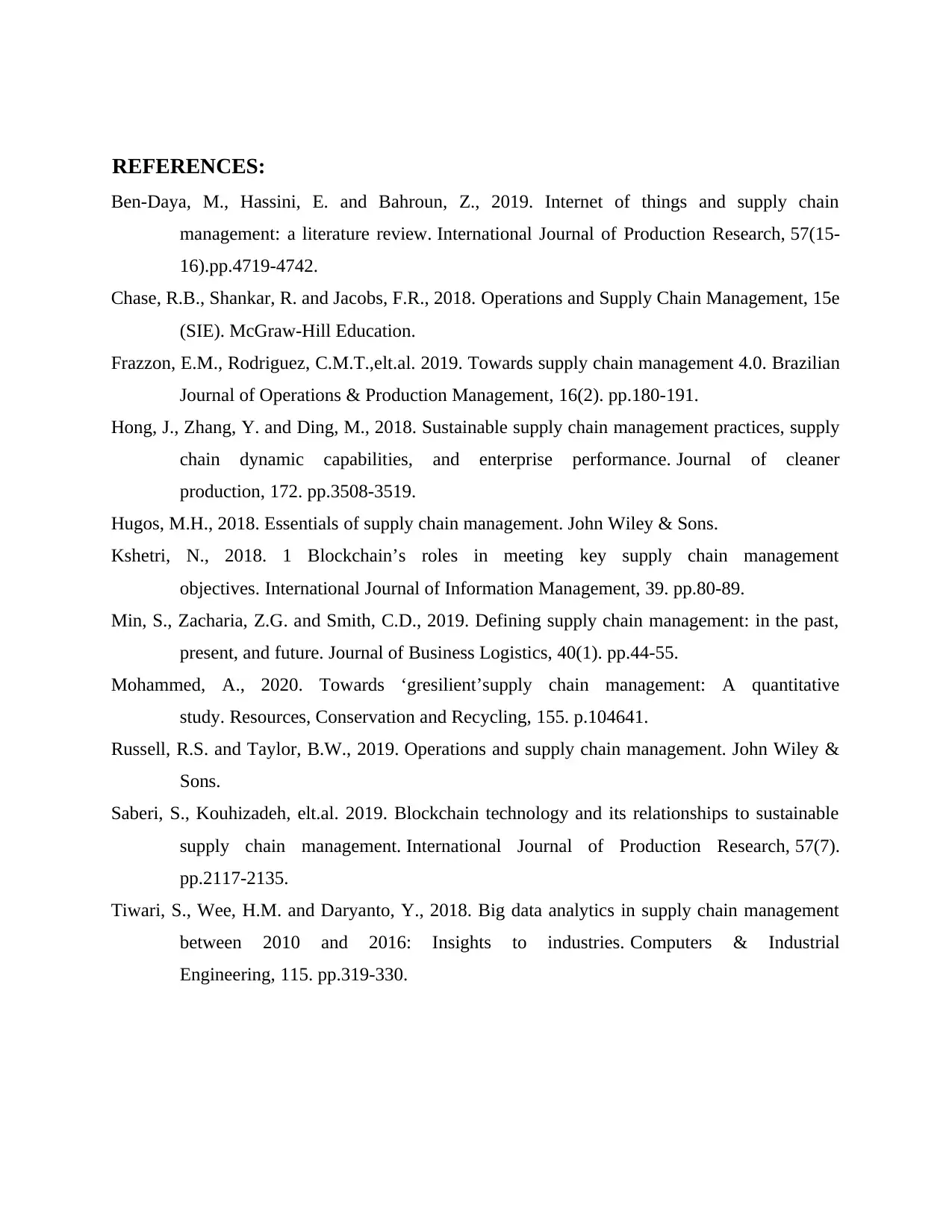
REFERENCES:
Ben-Daya, M., Hassini, E. and Bahroun, Z., 2019. Internet of things and supply chain
management: a literature review. International Journal of Production Research, 57(15-
16).pp.4719-4742.
Chase, R.B., Shankar, R. and Jacobs, F.R., 2018. Operations and Supply Chain Management, 15e
(SIE). McGraw-Hill Education.
Frazzon, E.M., Rodriguez, C.M.T.,elt.al. 2019. Towards supply chain management 4.0. Brazilian
Journal of Operations & Production Management, 16(2). pp.180-191.
Hong, J., Zhang, Y. and Ding, M., 2018. Sustainable supply chain management practices, supply
chain dynamic capabilities, and enterprise performance. Journal of cleaner
production, 172. pp.3508-3519.
Hugos, M.H., 2018. Essentials of supply chain management. John Wiley & Sons.
Kshetri, N., 2018. 1 Blockchain’s roles in meeting key supply chain management
objectives. International Journal of Information Management, 39. pp.80-89.
Min, S., Zacharia, Z.G. and Smith, C.D., 2019. Defining supply chain management: in the past,
present, and future. Journal of Business Logistics, 40(1). pp.44-55.
Mohammed, A., 2020. Towards ‘gresilient’supply chain management: A quantitative
study. Resources, Conservation and Recycling, 155. p.104641.
Russell, R.S. and Taylor, B.W., 2019. Operations and supply chain management. John Wiley &
Sons.
Saberi, S., Kouhizadeh, elt.al. 2019. Blockchain technology and its relationships to sustainable
supply chain management. International Journal of Production Research, 57(7).
pp.2117-2135.
Tiwari, S., Wee, H.M. and Daryanto, Y., 2018. Big data analytics in supply chain management
between 2010 and 2016: Insights to industries. Computers & Industrial
Engineering, 115. pp.319-330.
Ben-Daya, M., Hassini, E. and Bahroun, Z., 2019. Internet of things and supply chain
management: a literature review. International Journal of Production Research, 57(15-
16).pp.4719-4742.
Chase, R.B., Shankar, R. and Jacobs, F.R., 2018. Operations and Supply Chain Management, 15e
(SIE). McGraw-Hill Education.
Frazzon, E.M., Rodriguez, C.M.T.,elt.al. 2019. Towards supply chain management 4.0. Brazilian
Journal of Operations & Production Management, 16(2). pp.180-191.
Hong, J., Zhang, Y. and Ding, M., 2018. Sustainable supply chain management practices, supply
chain dynamic capabilities, and enterprise performance. Journal of cleaner
production, 172. pp.3508-3519.
Hugos, M.H., 2018. Essentials of supply chain management. John Wiley & Sons.
Kshetri, N., 2018. 1 Blockchain’s roles in meeting key supply chain management
objectives. International Journal of Information Management, 39. pp.80-89.
Min, S., Zacharia, Z.G. and Smith, C.D., 2019. Defining supply chain management: in the past,
present, and future. Journal of Business Logistics, 40(1). pp.44-55.
Mohammed, A., 2020. Towards ‘gresilient’supply chain management: A quantitative
study. Resources, Conservation and Recycling, 155. p.104641.
Russell, R.S. and Taylor, B.W., 2019. Operations and supply chain management. John Wiley &
Sons.
Saberi, S., Kouhizadeh, elt.al. 2019. Blockchain technology and its relationships to sustainable
supply chain management. International Journal of Production Research, 57(7).
pp.2117-2135.
Tiwari, S., Wee, H.M. and Daryanto, Y., 2018. Big data analytics in supply chain management
between 2010 and 2016: Insights to industries. Computers & Industrial
Engineering, 115. pp.319-330.
Paraphrase This Document
Need a fresh take? Get an instant paraphrase of this document with our AI Paraphraser

1 out of 11
Related Documents
Your All-in-One AI-Powered Toolkit for Academic Success.
+13062052269
info@desklib.com
Available 24*7 on WhatsApp / Email
![[object Object]](/_next/static/media/star-bottom.7253800d.svg)
Unlock your academic potential
Copyright © 2020–2025 A2Z Services. All Rights Reserved. Developed and managed by ZUCOL.





